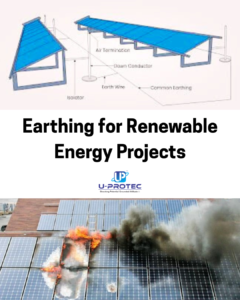Earthing for Renewable Energy Projects: Why It’s Crucial

Introduction
In the rapidly growing renewable energy sector, ensuring the safety and reliability of systems is paramount. One of the often overlooked yet vital components of renewable energy projects like solar farms and wind turbines is earthing—also known as grounding. Proper earthing for renewable energy projects is essential to protect equipment, ensure safety, and comply with regulations.
In this blog, we will dive into why earthing is crucial, how it works, and best practices to implement it effectively.
What Is Earthing
Earthing means connecting electrical systems and equipment to the ground to safely dissipate excess electrical current. It helps prevent electric shocks, damage to equipment, and electrical fires caused by faults such as lightning strikes or insulation failures.
Why Is Earthing Crucial for Renewable Energy Projects?
- Safety of Personnel
Renewable energy installations often operate in outdoor environments where electrical faults can pose serious risks. Proper earthing protects workers and users from electric shocks by safely redirecting fault currents into the earth.
- Equipment Protection
Surges from lightning and electrical faults can damage expensive components like inverters, transformers, and control units. Earthing systems protect this equipment by providing a safe path for high voltage currents.
- System Performance and Reliability
A well-designed earthing system reduces electromagnetic interference and electrical noise, enhancing the performance of sensitive equipment such as sensors and communication devices.
- Regulatory Compliance
Most countries mandate specific earthing standards for electrical installations. Following standards such as IEC 60364 and IEEE 80 ensures compliance, avoiding penalties and operational delays.
- Efficient Fault Detection
Earthing helps in quickly detecting and isolating faults, facilitating faster maintenance and reducing downtime.
Types of Earthing
- System Earthing: Connecting the neutral point of transformers or generators to earth.
- Equipment Earthing: Grounding metallic parts of electrical equipment that do not carry current.
- Lightning Protection Earthing: Specialized grounding systems to safely dissipate lightning strikes.
Best Practices for Earthing Renewable Energy Projects
- Conduct Soil Resistivity Tests: Understand the soil’s conductivity to design effective grounding systems.
- Use Corrosion-Resistant Materials: Copper and galvanized steel ensure longevity.
- Maintain Low Ground Resistance: Aim for resistance below 1 ohm to ensure safety and performance.
- Regular Inspection and Maintenance: Earthing systems should be tested periodically.
- Integrate with Lightning Protection: Especially important for wind farms and large solar arrays.
Common Challenges
- High soil resistivity in rocky or dry areas
- Corrosion due to saline or acidic soil conditions
- Poor coordination between design and installation teams
- Inadequate testing and maintenance procedures
Conclusion
Earthing is a fundamental safety and performance aspect of renewable energy projects. It protects lives, safeguards equipment, improves system efficiency, and ensures compliance with safety regulations. As renewable energy installations become more widespread, prioritizing proper earthing is crucial for long-term success.
